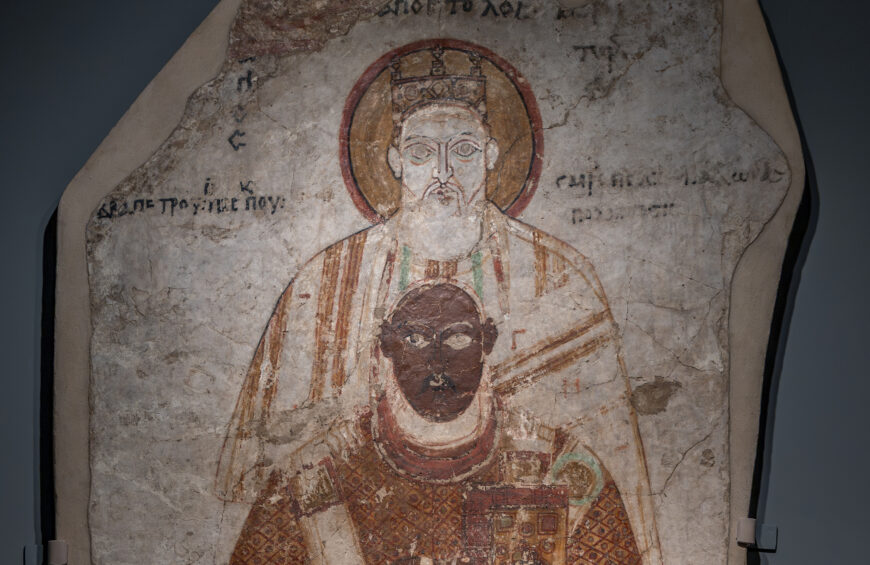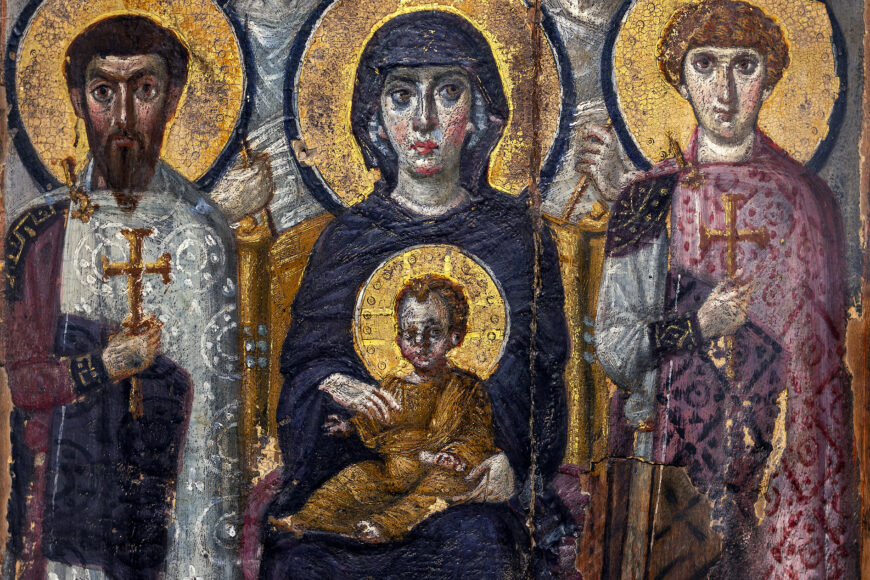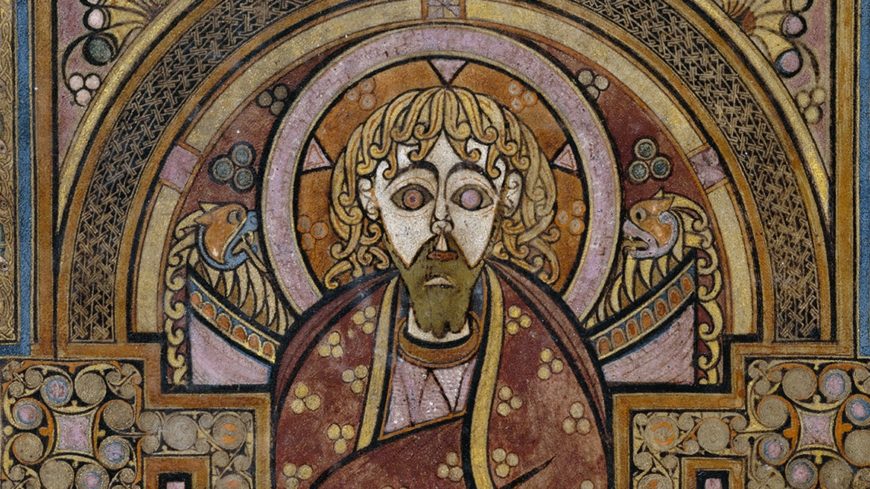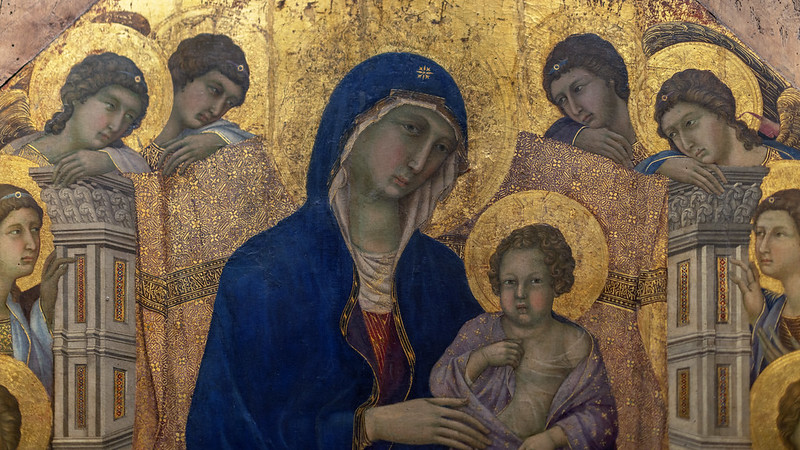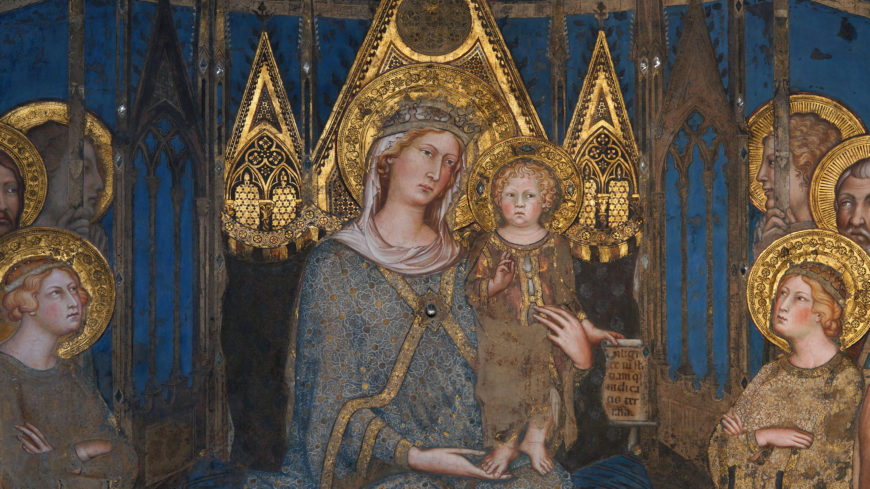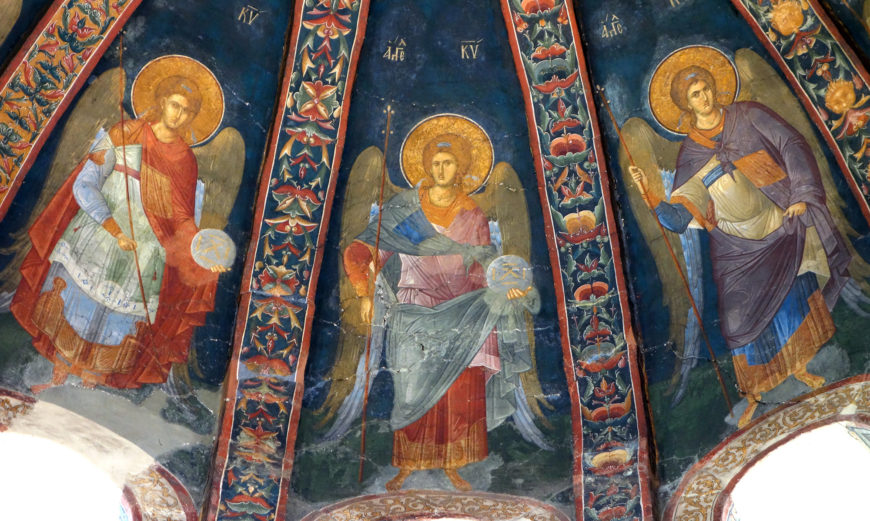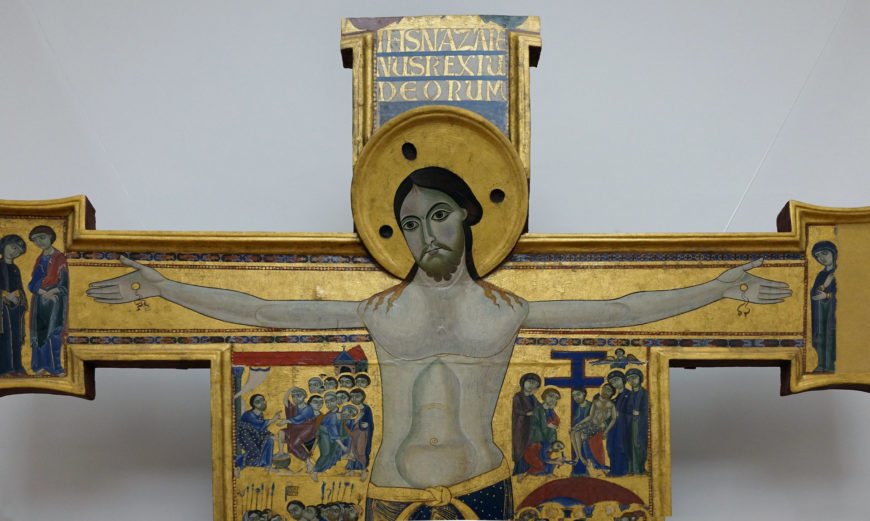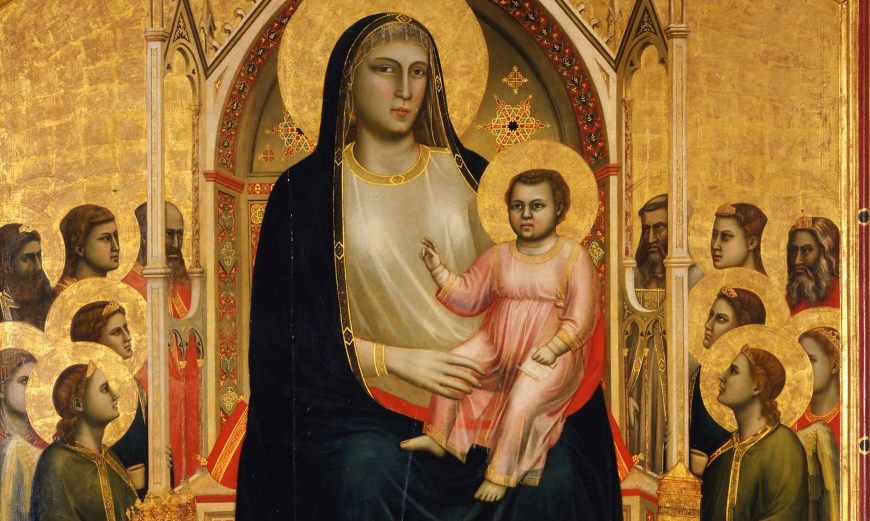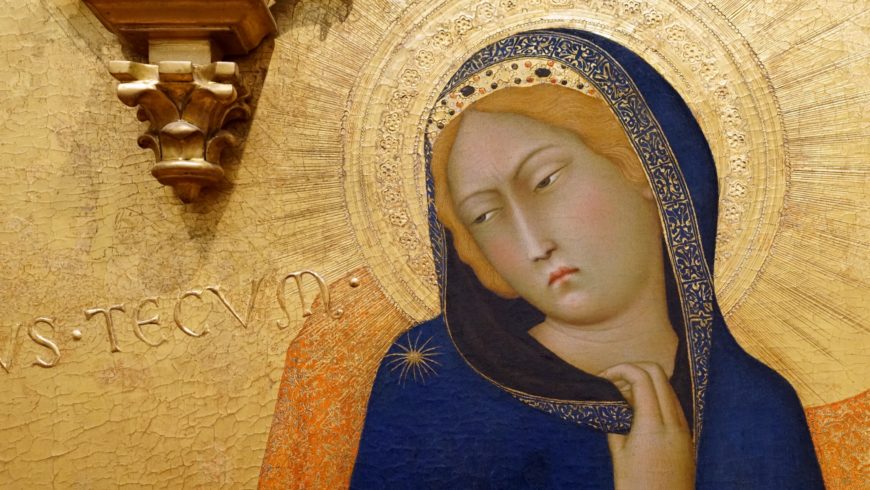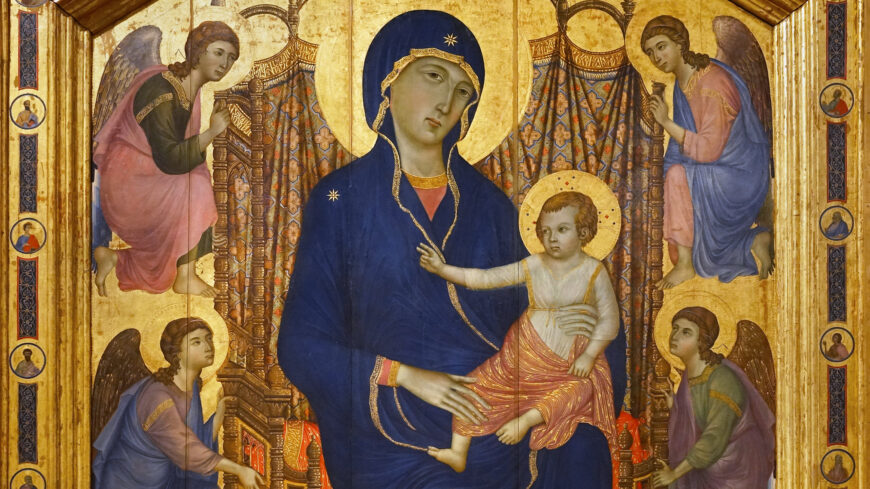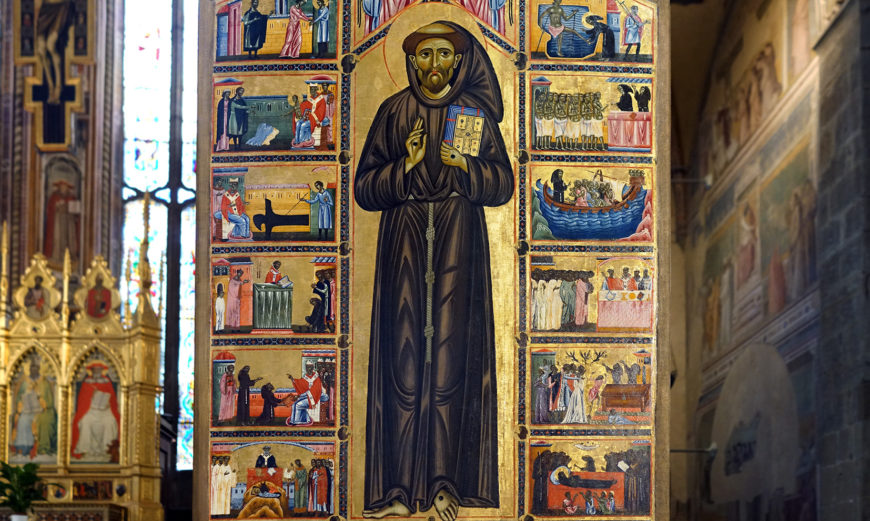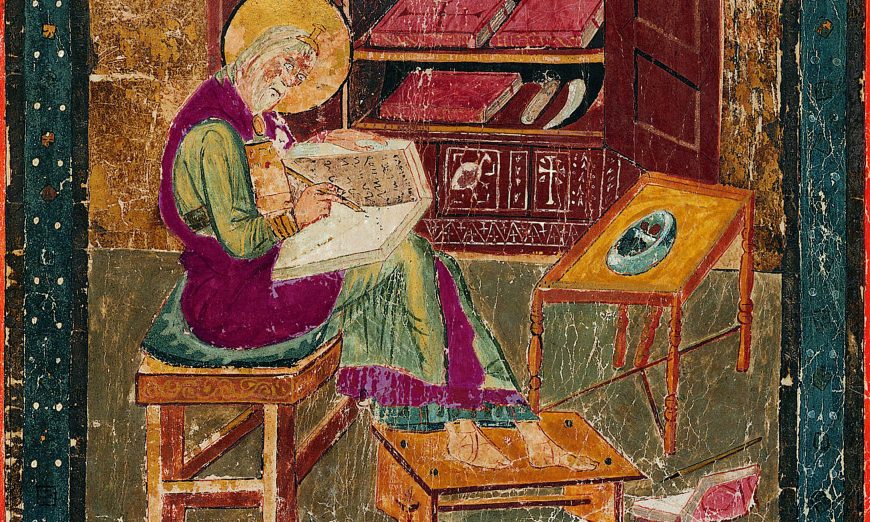Bonaventura Berlinghieri, Saint Francis Altarpiece, c. 1235, tempera on wood, 5′ high (San Francesco, Pescia, Italy)
Bonaventura Berlinghieri, Saint Francis Altarpiece
[0:00] [music]
Dr. Steven Zucker: [0:03] When we think about the great tradition of religious painting in the West, the great Christian tradition, we often think of painting on panels, but where did that begin?
Dr. Beth Harris: [0:14] We begin to really see painting in the West in the 12th and 13th centuries.
Dr. Zucker: [0:19] One of the most famous examples of this is an altarpiece by Bonaventura Berlinghieri known as the “St. Francis Altarpiece.”
Dr. Harris: [0:27] This is a life-sized altarpiece, so Francis is about five feet high. It would have stood on an altar and would have been the focus of religious meditation, of prayer.
Dr. Zucker: [0:37] Although the depiction of the figure of Francis is a common height, this is not a naturalistic depiction.
Dr. Harris: [0:43] And that’s part of the point. This is within 10 years of Francis’s death and canonization. He’s just been made a saint, and so part of the purpose of this image is for his followers to show his saintliness, the miracles that he performed, to depict him as a person who is blessed by God.
Dr. Zucker: [1:05] Who was Francis? He’d been born into a prosperous family, but as a young man he had had some kind of intense religious vision and he renounced his worldly possessions. According to some stories, he actually took the fine clothes off his back and threw them back at his father.
Dr. Harris: [1:22] What was important for Francis and for his followers was to live a life of poverty, to follow the example of Christ. Now the Franciscans, the order that comes from Francis’ teaching, was a mendicant order — they lived by begging — and they lived in the relatively new cities that existed in Italy.
Dr. Zucker: [1:40] This was a moment of transition between this period that we know as the medieval or the Middle Ages and what will eventually become the Renaissance.
Dr. Harris: [1:48] In the new cities in Italy and elsewhere in Europe, we have the beginning of a merchant class, the beginning of an accumulation of wealth which will help to power the Renaissance.
Dr. Harris: [1:58] What are we learning about Francis when we look at Berlinghieri’s altarpiece? We’re convinced of his spirituality. He is placed within this gold background, this gold leaf that’s been applied to the wood that is the support for the altarpiece.
Dr. Zucker: [2:13] This is the light of heaven, and very much in the medieval tradition, the artist has been perfectly happy to distort the proportions of the body, lengthening him.
Dr. Harris: [2:23] Not only is he elongated, but he seems to almost float above the ground. There’s a weightlessness to him. The brown drape that he wears, that’s adopted by the monks in his order, hides his body underneath. We don’t have an interest in the human body. This is not a man of the body. We’re seeing Francis as spirit here.
Dr. Zucker: [2:43] That brown robe, and the simple belt made out of rope, and the fact that he’s not wearing any shoes — he’s barefoot — all of these things are symbols of his humbleness in the world, of the way in which he renounced the world’s wealth, the world’s pleasures, to live a life that was as close to Christ as possible. What he’s showing us as he lifts his hand and exposes his palm is the stigmata.
Dr. Harris: [3:07] These are the wounds that Christ received on the cross that are appearing miraculously on the body of Francis. You can tell that it was important to the monks, the Franciscans, who commissioned this altarpiece. This is the earliest dated Franciscan altarpiece.
[3:25] You can tell that it was important to the monks to highlight the stigmata, this incredible miracle that Francis received, but there are lots of things about Francis’ life that made him very popular.
Dr. Zucker: [3:36] We can see those things depicted in the apron scenes that surround the central figure of Francis. If we start in the upper left, you see St. Francis kneeling in the wilderness. This is a very schematic representation, very much in this late medieval style.
[3:50] You can see that he’s looking up and praying to the seraphim, that is, this angelic figure. It is at this moment that Francis has this vision and then receives the stigmata.
Dr. Harris: [4:01] Below we see a very important moment for Francis’ followers, and this is Francis preaching to the birds. This idea of preaching to the lowliest creatures resonated with Francis’ message of preaching to the poor.
Dr. Zucker: [4:16] It’s important to note that the Franciscans and the other mendicant orders would often build churches on the outskirts of cities in order to reach the poor that lived not in the city center but at its edges.
[4:28] I love the representation of the preaching to the birds, and I love especially that small little mountain that is this landscape, this stand-in for nature, but it’s so stylized.
[4:38] Now, the four remaining apron scenes are all representations of posthumous miracles, that is, miracles that were associated with Francis after his death, and they have to do largely with healing the disabled, or, in the case of this scene at the bottom right, of a kind of exorcism, or removing of demons.
Dr. Harris: [4:54] Those scenes where we see St. Francis healing are meant to help identify him with Christ and the apostles, and thereby also to convince us of his saintliness, his holiness.
Dr. Zucker: [5:07] This is a painting that really does express a divine authority.
Dr. Harris: [5:10] In the early 13th century, Byzantine icons — that is, images of the Madonna, images of saints in a flat gold background — increasingly came to Italy and influenced artists there like Berlinghieri. The Byzantine influence is in the elongation of the figure, its flatness, and in that gold background.
[5:30] Here we’re seeing many elements that are typical of the Byzantine figures that are frontal, weightless, elongated, that gold light of heaven. In less than a century with Giotto, we’re going to see an interest in human beings who are in much more natural proportions, a renewed interest in a realistic, believable, earthly setting for figures.
[5:53] It’s fascinating to see this early moment in Italian painting and the influence of the Byzantine Empire.
[6:00] [music]
| Title | Saint Francis Altarpiece |
| Artist(s) | Bonaventura Berlinghieri |
| Dates | c. 1235 |
| Places | Europe / Southern Europe / Italy |
| Period, Culture, Style | Medieval / Gothic |
| Artwork Type | Painting |
| Material | Tempera paint, Panel |
| Technique |


